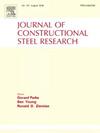Model test of double-deck steel truss bridge with arched stiffening chord
IF 4
2区 工程技术
Q1 CONSTRUCTION & BUILDING TECHNOLOGY
引用次数: 0
Abstract
This study investigated the mechanical performance of double-layer steel truss bridges with arched stiffening chords and their impact on the truss structure. Based on the 1412 m Xi'an Metro Line 10 bridge over the Wei River, a 1:30 scale test model of the three central spans (168 + 300 + 168 m) was established using similarity theory. A model test was conducted to investigate the overall mechanical performance of the double-layer steel truss continuous beam as well as the interaction mechanism and failure modes between the beam and the upper arched stiffening chord. The results indicated that under full-span loading, the upper arched stiffening chords increased the stiffness of the midspan by 37.9 %, effectively reducing the midspan displacement. The addition of arched stiffening chords altered the load path and transferred some forces from the truss structure through the montants at mid-span to the stiffening chords, and finally to the montants above the supports. This results in increased stress in the web members above the supports and reduced stress in the upper chords. The initial failure occurred via buckling of the web members above the supports, followed by yielding of the lower chords, ultimately leading to overall structural failure, at which point the arched stiffening chords remained in the elastic stage.
求助全文
约1分钟内获得全文
求助全文
来源期刊

Journal of Constructional Steel Research
工程技术-工程:土木
CiteScore
7.90
自引率
19.50%
发文量
550
审稿时长
46 days
期刊介绍:
The Journal of Constructional Steel Research provides an international forum for the presentation and discussion of the latest developments in structural steel research and their applications. It is aimed not only at researchers but also at those likely to be most affected by research results, i.e. designers and fabricators. Original papers of a high standard dealing with all aspects of steel research including theoretical and experimental research on elements, assemblages, connection and material properties are considered for publication.
 求助内容:
求助内容: 应助结果提醒方式:
应助结果提醒方式:


